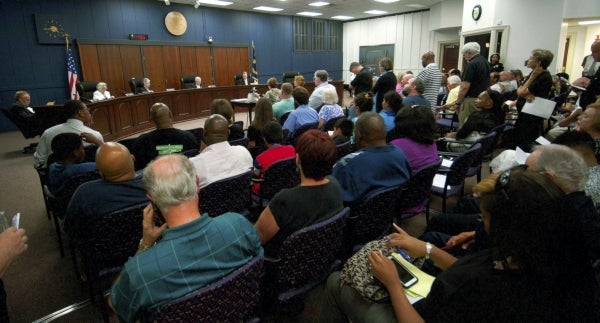Editorial: City must move past churning over same ‘Fame’ arguments
Published 12:05 am Sunday, May 26, 2019

- Forty-two concerned citizens stepped up to voice their concerns on the topic of Salisbury's Confederate Monument at a July 2015 City Council meeting.
What now?
That was the question raised by Timothy Bates in 2015 when a standing-room-only crowd produced 42 speakers about the Salisbury monument to Confederate soldiers known as “Fame.”
The real fight or debate wasn’t about whether the monument should stay or go. Instead, the City Council should talk about problems such as racism, employment, economic disparities, neighborhoods and crime, Bates and other speakers said.
Four years later, have we made progress on those issues? Yes. The City Council passed a Resolution of Reconciliation aimed at publicly condemning lynchings that occurred in the early 1900s and committing to work to remedy racism’s many modern-day manifestations. Lately, there’s been work, too, by the city to identify impediments to fair housing. We’ve also seen progress through city programs such as BlockWork to improve the look of neighborhoods and provide financial assistance for homeowners to make renovations. Crime rates have seen marked improvements.
But on the issue of “Fame,” our community is just as divided, if not more so, than in 2015. And unless there’s progress in devising a mutually agreeable solution, Salisbury seems destined to continuously churn over the same solutions — leave it as is, create a 21st-century interpretive marker nearby, engrave the base of the monument with new words or move it elsewhere.
Mayor Al Heggins has invited a number of groups to a meeting Tuesday morning in an attempt to stoke further conversation about the topic. Groups invited include the United Daughters of the Confederacy, to which the city transferred land where the monument sits decades ago; the Sons of Confederate Veterans; the Salisbury-Rowan NAACP; and others. Following two incidents of vandalism at the monument — one in August and one in March — Heggins said she wants to be proactive and “engage in deliberative discourse that can model for our city what human respect and empathy look like for vastly differing perspectives.” People should come to the meeting with open minds, open hearts and open ears, she said.
Other than an email from Heggins to various groups, there is no predetermined agenda for the meeting. But the words “deliberative discourse” presuppose that there will be a discussion about options for the monument.
Realizing that the passage of time may stoke new debates decades in the future, we think finding a means by which our community can move forward now is an appropriate goal. Under conservative, liberal and indifferent administrations at all levels, social matters have been the business of government because human relations are a critical part of ensuring that things run smoothly or operate at all.
The unfortunate reality is that many in our community, including those invited to the meeting, simply aren’t interested in discussing “what now?” For the Sons of Confederate Veterans, there’s nothing to talk about; a state law governs the monument’s location and, therefore, a representative will not attend Tuesday’s meeting, reporter Liz Moomey wrote in an article published Friday (“Mayor invites groups to discuss ‘Fame’ monument”). If others follow suit, the discussion quickly becomes one-sided — an even balance of groups opposed to and supportive of “Fame” remaining at its current location have been invited — and our community is no closer to solving one of its most divisive issues.
So, what now? If we seek to make progress on the issue of “Fame,” including making changes to the context or location of the monument, Heggins and those who are stakeholders, including the Sons of Confederate Veterans, must work toward the difficult task of having conversations about the future of “Fame,” however uncomfortable they may be.


